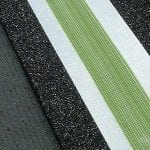Applications
Install a resistant artificial lawn

If you’re thinking of putting Green in your outdoor area, a beautiful and easy option to install and maintain, is artificial grass. Following, from Quilosa we advise you step by step for its installation, with the help of our product Quilosa BP-390 and binding band.
First, prepare the ground:
• Eliminates old gras sor weeds, as well as stones or mounds. Flatten as much as possible so that the ground is as regular as possible. If you want, you can place gravel or silica sand, so the ground will drain better. In this case, be sure to extend it and compress it well with a roller.
• Next, place an anti-weed mesh, so you’ll avoid the growth of unwanted vegetation below the artificial lawn you are going to install. This mesh is easy to fix with picks or nails.
Put the grass in its place:
• Measure the area and cut the grass roll. This point is very important. If we measure and cut before installation, we can take better advantage of the grass roll, as it usually comes in a two meter format. Look closely at the holes you have to leave for bushes or sprinklers. The key to a good installation is that we’ve a good anchorage of the artificial mantle on the ground.
• Place and glue the artificial lawn: once you have your pieces cut to size, touch them adhering to the ground. Below we explain how:
1. Maintain a 2 or 3mm gap between the artificial lawn rolls. They shouldn’t be mounted on each other.
2. To place the binding band (link al producto), lift the sides of the lawn rolls, leaving a separation of about 30cm.
3. Place between the two pieces of band and make sure it’s clean and free of dust.

4. Apply on the band, the adhesive Quilosa BP 390, with the help of a spatula.
5. Join the two pieces, without overlapping. Press a little, placing some weight on top to ensure proper adhesion.

A Strong and durable bonding system
With the union of our two products: bonding band and artificial lawn adhesive, a system is formed in which a special bonding band and a two-component polyurethane glue are combined. With them it’s possible to glue the different rolls of grass to each other, offering excellent resistance, thanks to which it’s possible to make its pieces look like one.


